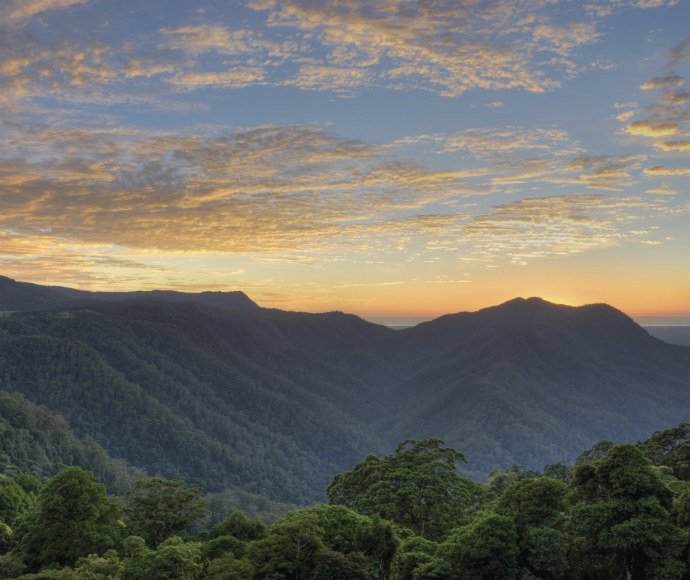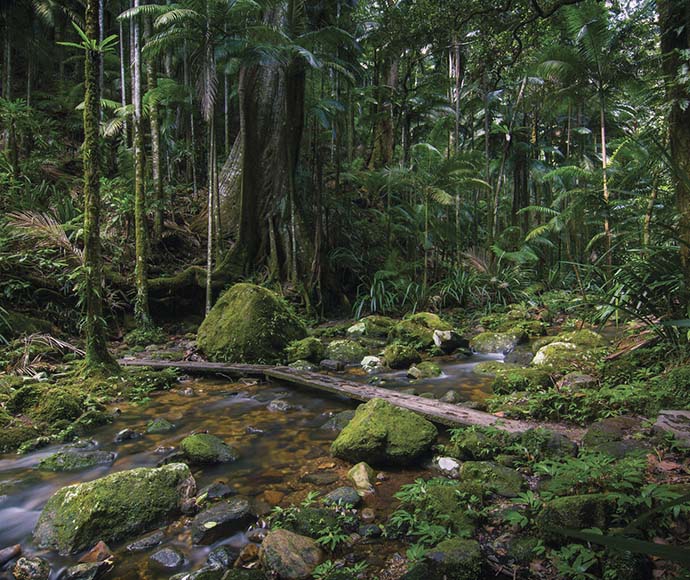This World Heritage-listed property is a series of rainforest national parks and reserves in north-east New South Wales and south-east Queensland. It contains:
- large areas of subtropical rainforest
- nearly all the Antarctic beech cool temperate rainforest in the world
- large areas of warm temperate rainforest
- many plants and animals that are very much like their ancestors in the fossil record
- many rare and threatened species
- eroded craters of extinct shield volcanoes.
World Heritage listing
Formerly known as the Central Eastern Rainforest Reserves of Australia, this property was first placed on the World Heritage List in 1986 and extended in 1994. It is World Heritage listed because it represents outstanding examples of major stages of the Earth’s evolutionary history, ongoing geological and biological processes, and exceptional biological diversity.
A wide range of plant and animal lineages and communities with ancient origins in Gondwana survive in this collection of reserves. The Gondwana Rainforests also provides the principal habitat for many threatened species of plants and animals, many of which are restricted largely to or entirely within the Gondwana Rainforest reserves (Gondwana Rainforests, UNESCO).
The property’s name was changed to the Gondwana Rainforests of Australia in 2007 to better reflect the values of the property and the 40 separate component reserves it covers.
The Gondwana Rainforests is also listed on the NSW State Heritage Register and the National Heritage List.
Management committees
On-the-ground management of the Gondwana Rainforests of Australia is largely done by:
- the NSW National Parks and Wildlife Service (NPWS, part of the Department of Climate Change, Energy, the Environment and Water)
- the Queensland Parks and Wildlife Service (QPWS, part of the Queensland Department of Environment, Tourism, Science and Innovation).
The World Heritage values of the property are managed and protected through a variety of park programs, including threatened species programs and regional planning initiatives.
Coordination of management for serial World Heritage properties is required under the World Heritage Convention. This is achieved through cross-jurisdictional strategic planning and cooperative management by intergovernmental management committees (the Gondwana Rainforests Management Committee and the Gondwana Rainforests Coordinating Committee), comprising representatives of:
- the Australian Government Department of Climate Change, Energy, the Environment and Water
- the NSW National Parks and Wildlife Service
- the Queensland Department of Environment, Tourism, Science and Innovation.
Advisory committees
The Gondwana Rainforests of Australia World Heritage property includes 28 reserves in New South Wales and 12 reserves in Queensland. New South Wales has several mechanisms to involve the community in management and decision making for the property.
These include Aboriginal joint management agreements through native title Indigenous Land Use Agreements and other consultative arrangements (such as the Wollumbin Aboriginal consultative committee) and the NSW NPWS Regional Advisory Committees (RACs) which include Gondwana Rainforests reserves (North Coast RAC, Hunter Central Coast RAC and the Northern Inland RAC).
The Queensland components of the property are represented by the Queensland Government’s Gondwana World Heritage Advisory Committee.

